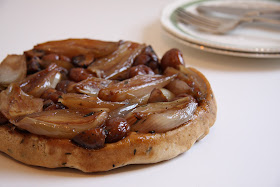 |
| Carrot, Cashew & Apricot Stuffing Balls |
These Carrot, Cashew & Apricot Stuffing Balls are crispy on the outside and soft in the middle. Lightly spiced, with little nuggets of sweetness from the dried apricots, they work as well with turkey or goose as they do with a vegetarian main course. In fact, I'd quite happily forgo the main event for a pile of these little morsels, roasties, buttered kale, honey and lime roasted parsnips and a huge jug of vegetarian gravy.
 |
| Carrot, Cashew & Apricot Stuffing Balls |
They taste just as good cold the day after, so make sure there are plenty to snack on when Boxing Day comes around. And if you do have happen to have some leftover (or if you make a double batch) they make great snacks for children (and adults).
 |
| Carrot, Cashew & Apricot Stuffing Balls |
Ingredients
50g cashew nuts
25g unsalted butter
1 small onion, finely chopped
1 medium carrot, peeled and coarsely grated
1 tsp ground cumin
zest of 1/2 unwaxed orange
100g fresh breadcrumbs
50g dried apricots (about 8), chopped
1-2 tbsp chopped flat leaf parsley
2 medium eggs, beaten
salt & black pepper (optional)
Method
Preheat the oven to 190C (170C fan).
Put the cashew nuts on a small baking tray and roast in the oven for 8-9 minutes, until they are a light golden colour. This really enhances their flavour, so well worth doing. Remove from the oven, leave to cool and then roughly chop. If you are feeding babies or very young children, you can pulse the cashew nuts in a food processor until they resemble breadcrumbs instead of chopping them so there's no risk of choking.
Whilst the cashew nuts are in the oven, put a small frying pan over a medium heat. Add the butter. Once the butter has melted add the onion and turn the heat down a little. Cook for 7-8 minutes, stirring often, until the onion has softened and is beginning to turn golden at the edges. Add the grated carrot and continue to cook, stirring often, for a further 5 minutes, until the carrot has softened. Add the ground cumin and cook for a minute or two.
Transfer the onion and carrot mixture to a large mixing bowl and leave to cool.
Once cool, add the orange zest, breadcrumbs, chopped dried apricots, chopped flat leaf parsley, roasted cashew nuts and season (I don't add salt as I cook for young children and there is already salt in the breadcrumbs, but if you are cooking for adults you will probably want to add salt and pepper to suit your tastes). Stir well to combine.
Line a baking tray with non stick baking paper.
Add the beaten egg to the mixing bowl, a little at a time, and mix well (I use sourdough breadcrumbs which seem to need a little more egg to combine, but you may not need the full amount, so add gradually). Form the mixture into 9 balls, each about the size of a golf ball, and place them on the lined baking tray.
Put the baking tray in the oven and bake for 20 minutes, until the stuffing balls are golden and a little crispy at the edges.
Serve hot or cold. The stuffing balls can be made ahead, cooled and frozen. Defrost thoroughly and then reheat in a medium oven for 7-8 minutes, until hot.
 |
| Carrot, Cashew & Apricot Stuffing Balls |




































